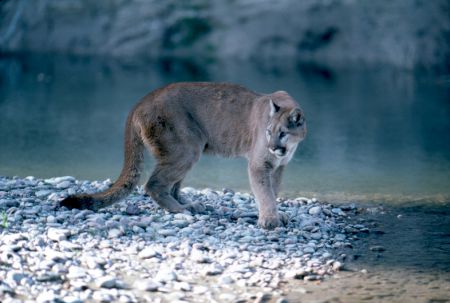The eastern cougar is the only 7 foot long, 200 pound wildcat that may or may not be living in your backyard.
This particular breed of predator is extraordinarily adaptable, ranging historically from as far north as the Yukon to the distant tip of South America, occupying habitat from coast to coast. They’re lean, muscular and renowned for their speed and stealth, with some researchers estimating the cougar’s top speed at 80 km/h. They’re excellent swimmers, climbers and can cover six metres in a single leap, preying mostly on deer, caribou and moose. Their fur ranges in colour from tawny to black.
For sometime now we’ve recognized two distinct subspecies of cougar in North America - the western and eastern populations. Although the western population is still very much alive and kicking, the past, present and future of the eastern cougar is hopelessly unclear.
It was originally thought the eastern cougar had been driven to extinction and to this day it’s still considered extinct in the United States. It might have received a similar designation in Canada were it not for persistent sightings across New Brunswick and Nova Scotia, with hundreds recorded between 1948-1971. From 1977 to 1992 the Canadian Wildlife Service recorded 425 sightings in those same regions. Unfortunately, no concrete evidence of a living eastern cougar came from any of these encounters, even if some stories were compelling.
Where it lived historically in Atlantic Canada is still a matter of debate, with some suggesting it abounded in every Maritime province except for Newfoundland. But we can be reasonably confident of its past tenure in at least New Brunswick.
In the last century we’ve found hair samples, footprints, scat...there have even been farm animals mauled by large and unidentified wildcats, but the most compelling evidence we have of present day cougars in Atlantic Canada came from a 2013 study where large scratching posts, not unlike those you purchase for a housecat, were set up in Fundy National Park and saturated with the urine of a female cougar. Hair left behind on these posts from visiting wildlife was analyzed and used to confirm that cougars still roamed the forests of New Brunswick.
Even with this long awaited confirmation, we are still left with a staggering number of questions. We still don’t have the first clue how many of these cougars are out there, how much of Atlantic Canada they occupy and how they are faring with our destruction of their habitat. We aren’t even certain if these hair samples were from true eastern cougars - survivors from a native population we failed to eradicate a century ago, or if these are escaped pets brought here from down south, repopulating a region emptied of large predators.
That’s right, people keep cougars as pets.
This wildcat is a modern mystery, pawing its way through the forests of our coast and carefully avoiding its two-legged tormentors, who at one time chased its into trees with dogs and shot it with systematic efficiency. Their justified fear of us has made it nearly impossible to understand and protect what few of them might remain, an arrangement so well enforced we’re liable to forget this awesome species still might call the Maritimes home.
The Blue Whale Campaign, is an initiative of Sierra Club Atlantic that is raising awareness of critically endangered species in the Gulf of St Lawrence. To learn more about the campaign and how to help visit http://www.sierraclub.ca/en/protect-the-gulf-of-st-lawrence or follow us on Twitter @bluewhaleatl @sccatlantic



